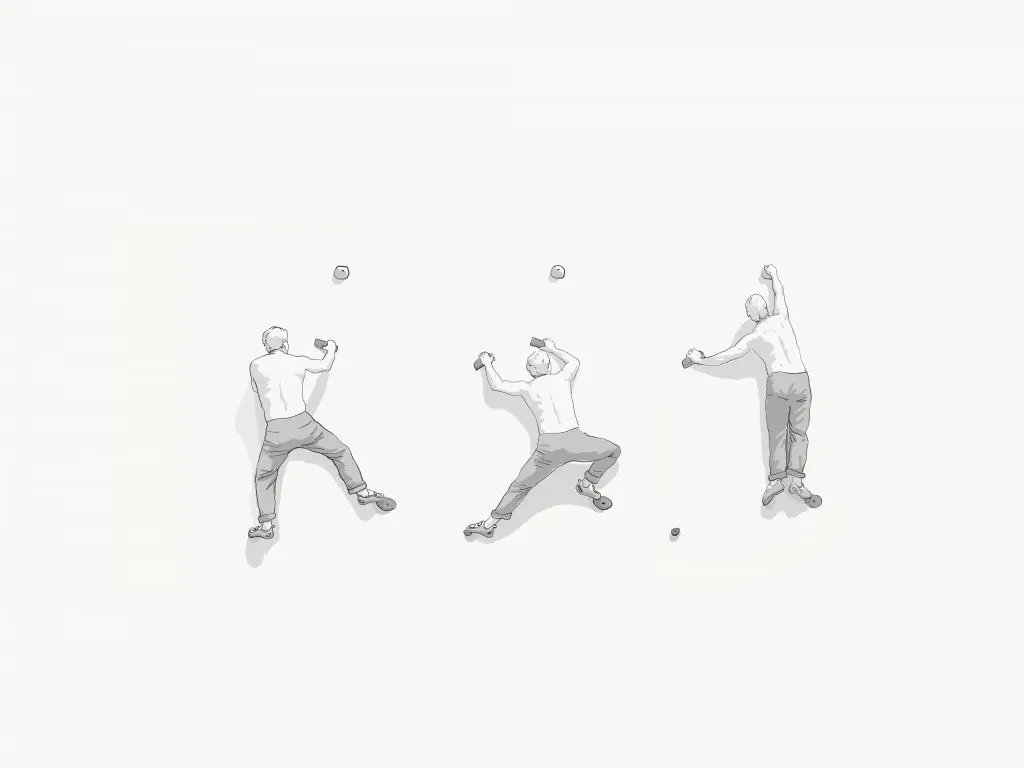It's All About Balance and Weight-Shifting.
Let’s get right into it. Here are the 3 steps to make you a better climber. And it all has to do with balance and weight-shifting.
Use the inside edge of your climbing shoe, get your hips over your heel, and flag your other leg.
Want more details and tips? Continue reading and by the end of this article, you’ll learn this technique to drastically improve your climbing. This is especially useful for new climbers. And if you have been climbing for a while, you might be surprised to learn you are intuitively doing these already.
The Basics: Walking Up Stairs is Similar To Climbing
Climbing a wall is very similar to climbing a set of stairs. We actually have a form of ‘climbing’ that is completely efficient by our definition.
When we climb stairs, we place one foot on a higher step, shift our hips over our heel and push up. This is all without requiring the assistance of our arms.
If you will note, we do not grab the banister and pull our bodies up the staircase. Nor do we place both feet on a single step and then ‘jump’ onto the next–at least not generally. Therefore, one leg at a time does the work of moving us upward.
The procedure involves shifting our weight over one foot, then the other as we push up. Now, make those steps wide enough, bolt them to a slab wall and try it over a mat, and you have a no-hands boulder problem!
Climbing is NOT About Doing Pull-ups
The preceding analogy may seem a bit strange to a new climber. Neither indoor climbing walls nor outdoor cliff faces, for instance, bear a resemblance to staircases. It is nonetheless quite apt.
Many new climbers come to the sport with a couple of misconceptions that frequently lead to inefficient habits.
The common belief is that climbing is an upper body-intensive activity. In other words, new climbers tend to attempt to “pull themselves” up the wall. They do this as if they intend to do pull-up after pull-up, almost dragging themselves from hold to hold while doing very little work with their legs.
This approach is needlessly wasteful of arm strength.
Remember, you would not attempt to drag yourself up a staircase using just the banister. The basic pattern of transferring the work of climbing a wall from our arms to our legs is virtually identical to walking up a set of stairs.
From One Foot to The Other
At the most basic level, climbers must first learn to shift their weight onto one foot or the other.
The foot that they shift onto is the foot that they are planning to push up on. This is almost invariably the higher of their two feet at the time.
It is sometimes referred to as the motion point. The other leg, discussed in more detail below, is the flagging leg, or in certain positions, the oppositional foot.
Weight-Shifting Broken Down into 3 Components
1) Footwork-Use the Inside Edge
The first step to making you a better climber is to focus on your feet.
When climbing at lower angles and easier routes, focus on standing on the inside edge of your climbing shoe. (Check out our article “Understanding Your Climbing Shoes,” if you need a quick refresher or basic understanding of your shoes.)
Remember to trust that your climbing shoe will distribute your weight properly, and relatively painlessly. Place your foot on a foothold and use the inside edge.
It is important to note that before you move your hips over that foot, your foot should be as close to parallel to the wall as possible (see picture below).

This involves, in most cases, rotating your heel toward the wall so that it almost touches. This will allow you to get your hips as close to the wall as possible, so that you can center your weight almost, if not entirely, over that foot.
2) Get Your Hips Over Your Heel
The second step in making you a better climber is to focus on your alignment.
When you look closely at a person’s body when balancing over one foot, you will notice that their hips are in vertical alignment with their heel. (It is NOT their toes or the center of their foot.)
As such, in the extreme case, a good, fully efficient position is similar to a person squatting on their haunches. (Or “a haunch” in this case, as we are only talking about carrying weight on one leg).
So, the process of effectively shifting weight in climbing is to swing your hips over and above the heel of the foot you are planning to stand up on. This is typically the higher of the two feet.
3) Flag Your Other Leg
The third step in making you a better climber is to use your leg for balance.
If you have ever seen a high wire performer you may have noticed that some carry a long pole as they walk across the wire. This is used to counterbalance their weight in the event that they begin to lean too far to one side or the other.
In climbing, the opposite leg (the one which you are not shifting your weight onto) performs a similar function.
This leg should be straight, at an angle to your other leg. It is like this so that it can be used to balance and help shift your hips onto the foot that is going to push.
Putting It All Together in Pictures
Let’s put it all together. Look at the following pictures. You will see a climber moving from 1) a starting position, 2) into a weight-shifted position (with their hips directly over their higher foot), 3) and finally standing up to reach the next handhold.

Note, the act of shifting your weight onto your ‘higher’ foot does not actually require raising your hips, but instead lowering them onto that foot.
So long as the higher foothold is at around knee level, or lower, weight-shifting involves moving your hips to the side and down onto the higher foot, as you can see in the picture. (If your higher foot is around thigh level or above, it requires “high-stepping”.)
Final Thoughts
Developing the feel for such moves is a key factor in moving through the grades, and it illustrates one of the trickiest aspects of learning good technique.
While it is useful to examine these moves by breaking them down into their components, in practice, when you must do a move, it is generally difficult to execute most skills ‘step by step.’
On the slab wall, it is almost possible to weight shift one step at a time. You can get your feet on the wall on your inside edge, push over onto your higher foot until your weight is fully there, then stand up on that one leg.
But, doing so in this manner, while technically correct, will often feel ‘wrong’ or, worse, even lead to a fall. This is because most skills in climbing require that you integrate several components into one fluid movement.
Simply trying to shift your weight by ‘Step one: place foot on the wall,’ ‘Step two: push lower leg straight,’ etc., will create a choppy feeling to the move, and eliminate nearly all of your momentum. The goal? Practice until it feels like a fluid motion.
Once you have this technique down, head over to our other article, ‘How to Climb on Slab Using This Technique‘ to incorporate your upper body.
3 Steps to Make You a Better Climber
Using these 3 steps to make you a better climber are simple. Remember to use the inside edge of your climbing shoe, get your hips over your heel, and flag your other leg for counterbalance! Now go out there and climb your little heart out.
All material is reprinted with the permission of the author. Copyright 2022 David H. Rowland. All rights reserved.




